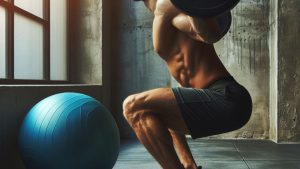When it comes to workouts targeting specific muscle groups, the squat stands tall as a versatile and efficient exercise. Often associated with building lower body strength, squats offer a plethora of benefits beyond just strengthening the quadriceps. But should squats be limited to once a week for enhancing weak quadriceps?

Understanding Squats and Quad Strength
Squats are a compound exercise that engages multiple muscle groups simultaneously. While they primarily target the quadriceps, they also involve the glutes, hamstrings, and lower back muscles. This compound nature makes squats an excellent choice not only for quad strength but for overall lower body development.
The Role of Squats in Strengthening Quads
Weak quadriceps can lead to imbalances and hinder overall lower body strength. Squats, with their emphasis on the quadriceps, are indeed a valuable exercise to address this weakness. Regular squatting can significantly improve quad strength, contributing to better mobility, stability, and athleticism.
Frequency of Squatting for Quad Strength
The frequency of squatting sessions for strengthening weak quads depends on various factors:
1. Training Experience
For beginners, incorporating squats two to three times a week can yield substantial improvements in quad strength. As one progresses, adjusting frequency based on recovery and performance becomes crucial.
2. Recovery and Adaptation
Muscles need time to recover and adapt to the stress imposed during workouts. Overtraining can lead to fatigue and hinder progress. Thus, spacing squat sessions to allow for adequate recovery is essential.
3. Individual Body Response
Every individual’s body responds differently to training stimuli. Some may thrive with more frequent squatting, while others might need longer recovery periods between sessions.
Beyond Quad Strengthening: Additional Benefits of Squats
While squats are excellent for strengthening weak quads, their benefits extend far beyond:
Core Strength: Maintaining proper form during squats engages the core muscles, aiding in overall core strength.

Improved Posture: Strengthening various muscle groups through squats helps in maintaining better posture.
Enhanced Functional Strength: Squats mimic daily movements, contributing to better functional strength and mobility.
Optimal Approach to Squats for Quad Strengthening
While targeting weak quads, the frequency of squatting should be determined by individual factors such as recovery, experience level, and body response. Instead of limiting squats to once a week, a more balanced approach involves:
Progressive Overload: Gradually increasing intensity and volume while allowing adequate recovery.
Supplementary Exercises: Incorporating other exercises like lunges, leg presses, or step-ups to complement squatting.
Consultation with a Trainer: Seeking guidance from a fitness professional to tailor a workout routine that optimally addresses weak quads.
So.
In essence, while squats are invaluable for strengthening weak quads, the key lies in balancing frequency, recovery, and overall workout programming. Regular assessment and a holistic approach to training yield the best results for quad strength and overall fitness.
Squat Variations to Target Weak Quads
1. Front Squats
Focus: Places more emphasis on the quadriceps compared to back squats.
Technique: The barbell rests on the front of the shoulders, encouraging an upright torso and engaging the quads.
2. Bulgarian Split Squats
Unilateral Focus: Targets each leg independently, allowing for better isolation and strengthening of the quads.
Technique: One foot elevated behind on a bench or platform while performing a squatting motion with the other leg.
3. Pause Squats
Enhanced Time Under Tension: Pausing at the bottom of the squat increases quad activation.
Technique: Lowering into a squat and holding the position for a few seconds before ascending.
Addressing Common Misconceptions
1. Squat Depth and Quad Activation
Misconception: Shallower squats are better for quad development.
Reality: Going through a full range of motion, including proper depth, engages the quads more comprehensively, leading to better development.
2. Quad Dominance and Knee Health
Misconception: Strengthening the quads excessively might lead to knee issues.
Reality: Balanced lower body training, including hamstring and glute strengthening exercises, helps prevent imbalances and potential knee problems.
Tailoring Squat Frequency to Individual Needs
Individualizing workout routines considering one’s body, goals, and limitations is crucial. The frequency and types of squats should align with one’s fitness objectives and capacity for recovery.
Final Thoughts
While squats are a cornerstone for developing quad strength, their frequency should be part of a well-rounded lower body workout routine. Incorporating various squat variations, complementing exercises, and ensuring adequate recovery can optimize quad development without limiting squats to a once-a-week regimen.
Understanding the nuances of training frequency, form, and supplementary exercises empowers individuals to address weak quads effectively while maximizing overall lower body strength and stability.
Remember to Listen to Your Body
Adaptation to workouts varies among individuals. Always pay attention to your body’s signals, prioritize proper form, and seek guidance from fitness professionals when necessary.
So, while squats are a fantastic tool for strengthening weak quads, their inclusion in a comprehensive lower body workout routine should be tailored to individual needs and goals.
Continuing the journey toward stronger quads and a more resilient lower body involves a balanced approach to exercise selection, frequency, and recovery.
Keep Squatting, Keep Growing.
External Resources for Further Reading:
American Council on Exercise – Proper Squat Technique
Healthline – Benefits of Squats Beyond Leg Day
Muscle & Fitness – Frequency of Squatting
American Council on Exercise – Proper Squat Technique
Healthline – Benefits of Squats Beyond Leg Day
Muscle & Fitness – Frequency of Squatting
Remember, your journey to stronger quads involves more than just squats! Incorporate variety and balance into your workouts for the best results.
Comparison tabular
| Squat Variation | Focus | Technique |
|---|---|---|
| Back Squats | Overall Lower Body | Barbell behind the neck, emphasizes glutes |
| Front Squats | Quadriceps Emphasis | Barbell in front, upright torso, targets quads |
| Bulgarian Split Squats | Unilateral Strength | One foot elevated, isolates each leg separately |
| Pause Squats | Time Under Tension | Pausing at bottom, increases quad activation |
| Overhead Squats | Full Body Engagement | Barbell overhead, engages core and lower body |
| Goblet Squats | Beginner-friendly | Holding a weight close to chest, full-body workout |
These variations cater to different fitness goals and target various muscle groups, offering versatility in training routines. Always ensure proper form and gradually progress in intensity when incorporating these variations into your workout regimen.
Wrapping up
In the pursuit of strengthening weak quads and achieving overall lower body strength, squats serve as a cornerstone exercise. However, it’s crucial to remember that fitness isn’t one-size-fits-all.
The frequency, variations, and approach to squats should align with your individual goals, fitness level, and body’s response to training. Incorporate a mix of squat variations, complementing exercises, and allow for adequate recovery to maximize quad development.
Listen to your body, seek guidance from fitness professionals when needed, and maintain a balanced workout routine. Remember, the journey to stronger quads isn’t just about squats; it’s about finding the right balance to unlock your lower body’s full potential.
So, keep squatting, keep exploring variations, and keep growing stronger, one rep at a time!

Hey there, it’s Mike Rrsq, the Editor-in-Chief over at Jsquat.com, and I’m absolutely obsessed with all things squat fitness! I’ve been lucky enough to get some serious recognition for my work in this field. With a solid background in the fitness and wellness industry, I’ve been there right from the get-go, helping shape this website into what it is today.
You see, I’m not just the boss around here; I’m also a passionate contributor. I love sharing my insights through my articles, and trust me, they’re not your run-of-the-mill stuff. Each piece I write is a labor of love, filled with my expertise and real-world experience in the fitness universe. So, if you’re into fitness and looking for some inspiration, you’re in the right place!
Related Posts
- Should squats make me feel challenged in my mental focus and concentration
The connection between physical exercise like squats and mental focus is fascinating. Let's dive into…
- Should front squats make You feel a challenge in your grip strength
Absolutely. Front squats can definitely challenge your grip strength. Unlike back squats where the barbell…
- The best mix of front squats and back squats for boosting leg strength in the Clean & Jerk and Snatch
Front squats and back squats are both essential exercises for building leg strength in weightlifting,…
- Unlocking Glute and Thigh Strength: Cossack and Sumo Squats for Women
In the pursuit of sculpted glutes and strong thighs, Cossack and Sumo squats have emerged…
- Why Do Squats Make Me Feel a Pump in My Quads: Explained)
Squats are a fundamental exercise in any leg training regimen. They engage multiple muscle groups,…
- Sissy Squats: Do they actually help grow quads and improve mobility
Are you looking to build strong, sculpted quadriceps while simultaneously improving your mobility? Look no…
- Why Very little leg growth from traditional squats despite gaining a lot of strength in the movement.
It's not uncommon to experience strength gains without seeing significant muscle growth, especially with traditional…
- Given that shrimp squats are not the best for strength should I plan a routine with limited equipment
Designing a workout routine with limited equipment requires some strategic planning. Shrimp squats are indeed…
